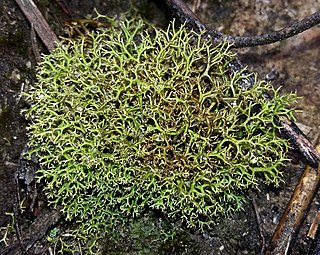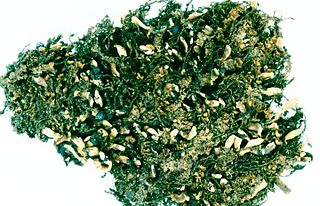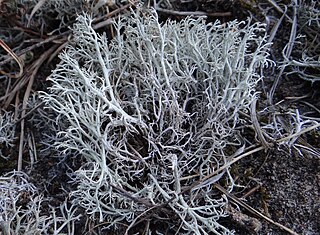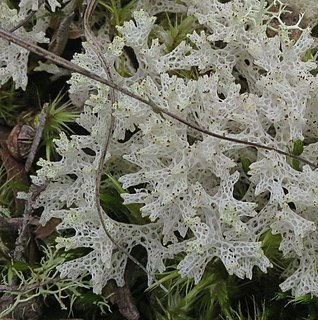
The Cladoniaceae are a family of lichenized fungi in the order Lecanorales. It is one of the largest families of lichen-forming fungi, with about 560 species distributed amongst 17 genera. The reindeer moss and cup lichens (Cladonia) belong to this family. The latter genus, which comprises about 500 species, forms a major part of the diet of large mammals in taiga and tundra ecosystems. Many Cladoniaceae lichens grow on soil, but other can use decaying wood, tree trunks, and, in a few instances, rocks as their substrate. They grow in places with high humidity, and cannot tolerate aridity.

Cladia is a genus of lichenized fungi in the family Cladoniaceae. Cladia species have a crustose primary thallus and a fruticose, secondary thallus, often referred to as pseudopodetium. The type species of the genus, Cladia aggregata, is widely distributed, occurring from South America, South Africa, Australasia and South-East Asia to southern Japan and India. Most of the other species are found in the Southern Hemisphere.

Cetradonia is a lichen genus in the family Cladoniaceae. A monotypic genus, Cetradonia contains the single species Cetradonia linearis. The genus was circumscribed in 2002 by Jiang-Chun Wei and Teuvo Ahti. The genus was once placed in the family Cetradoniaceae until that family was subsumed into the Cladoniaceae in 2006.
Teuvo ("Ted") Tapio Ahti is a Finnish botanist and lichenologist. He has had a long career at the University of Helsinki that started in 1963, and then following his retirement in 1997, at the Botanical Museum of the Finnish Museum of Natural History. Known as a specialist of the lichen family Cladoniaceae, Ahti has published more than 280 scientific publications. A Festschrift was dedicated to him in 1994, and in 2000 he was awarded the prestigious Acharius Medal for lifetime contributions to lichenology.
Cladonia wainioi or the Wainio's cup lichen is a species of cup lichen found in boreal and arctic regions of the Russian Far East and northern North America.

Cladonia sobolescens, commonly known as the peg lichen, is a species of fruticose lichen. It is found in temperate eastern North America and East Asia.

Cladonia subradiata is a widely distributed species of fruticose lichen in the family Cladoniaceae. It is found in Asia, Africa, Melanesia, Australia, New Zealand, and South, Central, and North America.

Cladonia arbuscula or the shrubby cup lichen is a species of cup lichen in the Cladoniaceae family.

Cladonia transcendens or the graduated cup lichen is a species of fruticose, cup lichen in the family Cladoniaceae.
Rexiella is a lichen genus in the family Cladoniaceae. The genus, originally circumscribed with the name Rexia by authors Soili Stenroos, Raquel Pino-Bodas, and Teuvo Ahti in 2018, was created to contain the species Cladonia sullivanii, first formally described in 1882 by Swiss botanist Johannes Müller Argoviensis. After publication of the new genus, it was discovered that the name was illegitimate, because an earlier homonym had been published; the generic name RexiaD.A.Casamatta, S.R.Gomez & J.R.Johansen had already been created in 2006 to contain the cyanobacterial species Rexia erecta. The new name Rexiella was therefore proposed in 2019. This name honours the Australian lichenologist Rex Filson, who published monographs on the genera Cladia and Heterodea.

Cladonia albonigra is a species of fruticose lichen in the family Cladoniaceae. It can be found as far south as Canada and the United States, and as far north as the Arctic Circle. It prefers acidic soils, and is known to host on trees of the genus Thuja.

Cladonia mitis is a species of fruticose lichen in the family Cladoniaceae. It was formally described as a new species in 1918 by German lichenologist Heinrich Sandstede. It has previously been classified in genus Cladina before molecular phylogenetic studies showed this to be a part of Cladonia. Cladonia mitis is morphologically quite similar to Cladonia arbuscula, and some authors have considered it to be a variety or subspecies of the latter. They differ mainly in the production of secondary compounds: Cladonia mitis produces chemicals in the rangiformic acid complex, which C. arbuscula does not.
Cladonia ahtii is a species of cup lichen in the family Cladoniaceae. It is found in Brazil, and grows in tropical moist broadleaf forests. The specific epithet honours Finnish lichenologist Teuvo Ahti.
Cladonia camerunensis is a species of lichen in the family Cladoniaceae. Found in Cameroon, it was formally described as a new species in 2016 by lichenologists Teuvo Ahti and Adam Flakus. The type specimen was collected on Minloua Mountain, west of Yaoundé, at an altitude of 780 m (2,560 ft). Here the lichen was found growing among plant debris over rock in open areas. The species is only known to occur in two locations on Minloua Mountain, which is a tropical inselberg. Secondary chemicals that are found in the lichen include barbatic acid and didymic acid.
Cladonia compressa is a species of lichen in the family Cladoniaceae. Found in Bolivia, it was formally described as a new species in 2016 by lichenologists Teuvo Ahti and Adam Flakus. The type specimen was collected by the second author near Siniari colony at an altitude of 2,186 m (7,172 ft). Here, in a Yungas secondary cloud forest, the lichen was found growing on the ground, in humus-rich mineral soil. The specific epithet compressa refers to the compressed podetia. Secondary compounds that occur in the lichen include fumarprotocetraric acid (major), and minor to trace amounts of protocetraric acid and physodalic acid.

Pulchrocladia retipora, most commonly known as the coral lichen, is a species of fruticose lichen in the family Cladoniaceae. It occurs in Australasia and New Caledonia where it grows in coastal and alpine heathlands. The lichen features coral-like branches and subbranches with numerous netlike perforations. It is known by multiple names, with some sources referring to it by its synonym Cladia retipora, or the common name lace lichen.
Pulchrocladia corallaizon is a species of lichen in the family Cladoniaceae. It was first formally described as Cladia corallaizon. The specific epithet corallaizon, modified from Greek, means "ever-living coral". In 2018, it was transferred to the newly circumscribed genus Pulchrocladia.
Pulchrocladia ferdinandii is a species of lichen in the family Cladoniaceae. It was first formally described as Cladonia ferdinandii by Swiss lichenologist Johannes Müller Argoviensis in 1882. The specific epithet honours German-Australian botanist Ferdinand von Mueller, who collected the type specimen near Esperance, Western Australia. Rex Filson transferred the taxon to Cladia in 1970. In 2018, it was transferred to the newly circumscribed genus Pulchrocladia.
Henricus (Harrie) Johannes Maria Sipman is a Dutch lichenologist. He specialises in tropical and subtropical lichens, and has authored or co-authored more than 250 scientific publications. He was the curator of the lichen herbarium at the Berlin Botanical Garden and Botanical Museum from 1983 until his retirement in 2010.

Cladonia rei, commonly known as the wand lichen, is a species of ground-dwelling, fruticose lichen in the family Cladoniaceae. It is a widely distributed species, having been reported from Africa, Asia, Australasia, Europe, and North America. It is identified by its slightly dirty-colored, rough-surfaced, slender podetia that grow up to 9 cm (3.5 in) tall. Diagnostic characters of the lichen include the continuously sorediate, green-and-brown-mottled, podetia that taper upward to a point, while chemically, it contains homosekikaic and sekikaic acids. Its reduced capacity to bioaccumulate toxic heavy metals from its surroundings, as well as its ability to switch photobiont partners, allows the lichen to colonize and survive highly polluted habitats. There are several other Cladonia species that are somewhat similar in appearance, but can be distinguished either by subtle differences in morphology, or by the secondary chemicals they contain.










